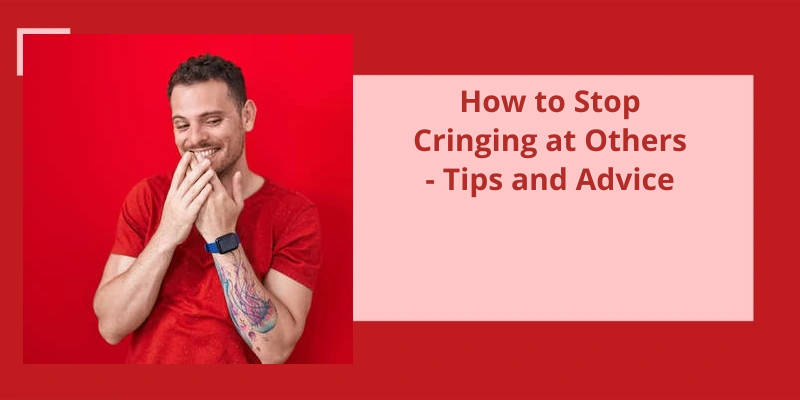Have you ever found yourself cringing at the actions or remarks of others? It's a common reaction, but it can also hinder our ability to connect and interact with people. If you want to break free from the cycle of cringing and truly enjoy social interactions, it's important to shift your focus towards benefiting others. Rather than being overly critical, strive to entertain, help, or uplift those around you. Approach conversations with genuine curiosity about the other person's life and thoughts, and practice being present and attentive. The more you put yourself out there and actively engage with others, the more natural and effortless these interactions will become. So, if you're ready to stop cringing and start thriving socially, read on for some valuable tips and advice.
Why Do Other Peoples Embarrassing Acts Make Us Cringe?
Why do other peoples embarrassing acts make us cringe? The feeling of cringing is rooted in our natural inclination towards socialization and conformity. As social creatures, we strive to adhere to certain social norms and expectations to maintain harmonious interactions within our communities. When we witness others engaging in socially undesirable behaviors, it triggers a reaction within us, causing embarrassment and discomfort. This reaction, known as cringing, is a form of vicarious or second-hand embarrassment that we experience.
Furthermore, cringing also acts as a form of social regulation.
Practicing mindfulness and self-awareness can help us become more present in the moment and less likely to be affected by the cringe-inducing actions of others. Additionally, cultivating a non-judgmental mindset can contribute to a more compassionate perspective, allowing us to accept people as they’re and refrain from cringing at their embarrassing moments.
Finally, it’s important to foster an environment where individuals feel safe to be themselves without fear of judgment or embarrassment. Creating a culture of acceptance and understanding can alleviate the pressure to conform to societal expectations and reduce the occurrence of cringing at others actions. Encouraging open dialogue and fostering empathy within our communities can contribute to a more compassionate society where cringing becomes less prevalent.
One particular example of a cringe-worthy behavior involves making others feel uncomfortable through mistreatment, judgmental attitudes, ignorance, or arrogance. Additionally, engaging in behaviors such as bragging or making awkward facial expressions while singing can also trigger a cringe response. These instances of embarrassment provoke a sense of discomfort, making us cringe at the behavior being displayed.
What Is an Example of a Cringe Behavior?
When it comes to cringe behavior, there are several examples that immediately spring to mind. One such behavior is mistreating others or acting in a disrespectful manner. This can include instances of bullying, condescending remarks, or deliberately making someone feel inferior. Witnessing such behavior can make us cringe as we empathize with the person on the receiving end and feel a sense of discomfort at the lack of compassion or kindness.
Another cringe behavior is being judgmental or holding ignorant beliefs. When someone openly expresses prejudiced views or makes sweeping generalizations without considering the diverse perspectives and experiences of others, it can elicit a cringe response. This behavior makes us cringe because it reveals a close-mindedness and unwillingness to engage in meaningful dialogue or empathy.
Stupidity and arrogance can also cause cringe-worthy moments. For instance, when someone confidently presents false information or makes overly simplistic statements without any evidence or critical thinking, their lack of intellectual humility can make us cringe. We’re often repelled by such behavior as it highlights a disregard for truth, intellectual growth, and the importance of valid reasoning.
Bragging excessively is another example of a cringe behavior. When someone constantly boasts about their achievements, possessions, or status, it can be off-putting and cringe-worthy. This behavior makes us cringe as it demonstrates a lack of humility and an excessive need for validation or superiority.
Furthermore, making weird faces while singing or performing can also be considered a cringe behavior. While everyone has their own unique mannerisms, some facial expressions can be particularly awkward or exaggerated, causing discomfort or embarrassment for those witnessing it. This cringe response is often a result of the discrepancy between societal norms of comportment and the individuals unconventional or flamboyant mannerisms.
Myriad cringe behaviors revolve around individuals engaging in embarrassing actions that make others uncomfortable or embarrassed on their behalf. These may involve mistreating others, being judgmental, displaying ignorance, arrogance, excessive bragging, or presenting unconventional behaviors while performing. Recognizing and understanding these cringe behaviors can help us navigate social interactions and promote a more empathetic and considerate society.
Source: Why do certain behaviours make us cringe? – PsychMechanics
Conclusion
Rather than fixate on the cringe-inducing moments, it’s more productive to shift our focus towards benefiting and engaging with others. By entertaining, helping, and uplifting those around us, we create positive interactions that build rapport and strengthen relationships. Adopting a genuine curiosity about other people's lives allows us to connect on a deeper level, fostering understanding and empathy. Like any skill, becoming more comfortable in social situations takes practice. The more we actively engage with others and step outside our comfort zones, the more natural and effortless socializing will become. So, let go of cringing, embrace the opportunities to connect with others, and enjoy the enriching experiences that come with it.






